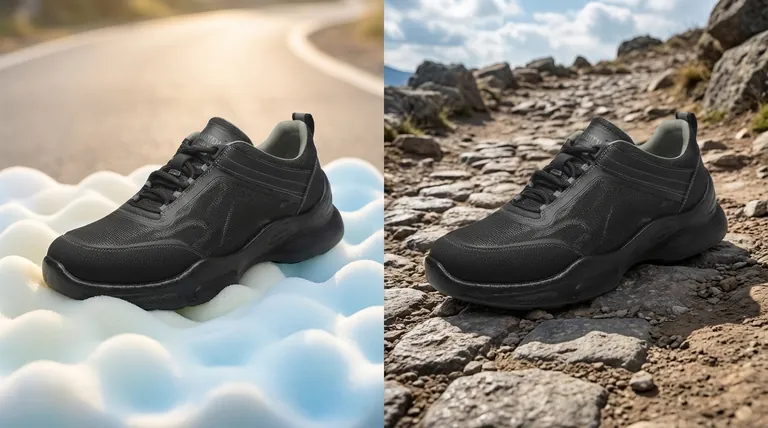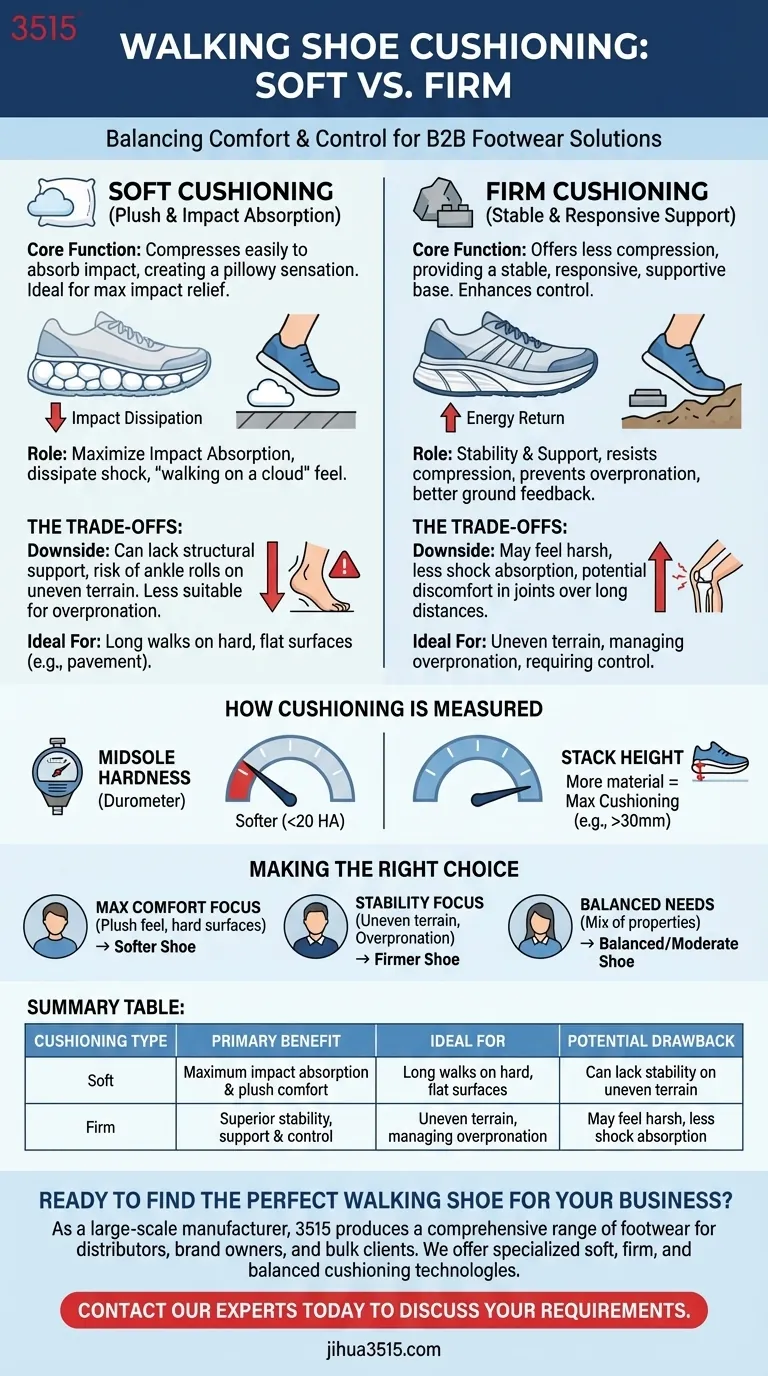At its core, the difference is a trade-off between comfort and control. Soft cushioning compresses easily to absorb impact, creating a plush, pillowy sensation underfoot. In contrast, firm cushioning offers less compression, providing a more stable, responsive, and supportive base that enhances control with each step.
Your choice between soft and firm cushioning is not about which is "better," but which is better suited to your specific foot mechanics, walking environment, and personal comfort preference. The goal is to find the right balance of impact absorption and structural support for your needs.

Why Cushioning Matters in a Walking Shoe
A walking shoe's primary job is to protect your feet and joints from the repetitive impact of striking the ground. The midsole, typically made of foam, gel, or air pockets, is the engine of this protection. The properties of this material dictate how the shoe feels and performs.
The Role of Soft Cushioning
Soft cushioning is designed for maximum impact absorption. The foam compresses significantly upon landing, dissipating the shock that would otherwise travel up your legs.
This creates that "walking on a cloud" sensation many people seek for immediate comfort, especially on hard, flat surfaces like pavement. These are often described as having "max cushioning."
The Role of Firm Cushioning
Firm cushioning is engineered for stability and support. It resists high levels of compression, creating a solid platform for your foot.
This is particularly beneficial for preventing your foot from rolling inward or outward excessively (overpronation). The firmness provides a more responsive feel, giving you better ground feedback and control.
Understanding the Trade-offs
Neither cushioning type is perfect; each comes with inherent compromises. Understanding these is critical to avoiding discomfort or potential injury.
The Downside of Too Much Softness
While initially comfortable, excessively soft shoes can lack structural support. On uneven terrain, a soft midsole may compress unpredictably, increasing the risk of ankle rolls.
For individuals who naturally overpronate, a very soft shoe can sometimes worsen the issue by failing to provide the necessary support to guide the foot into a neutral position.
The Downside of Too Much Firmness
A shoe that is too firm may not provide enough shock absorption for your needs, which can lead to discomfort in your heels, shins, or knees over long distances.
The feeling can be described as "harsh" or "unforgiving," and it may not be comfortable for those with sensitive feet or conditions like plantar fasciitis who need more pressure relief.
How Cushioning is Measured
While "soft" and "firm" are subjective, there are objective ways to measure these properties.
Midsole Hardness (Durometer)
Technicians use a tool called a durometer to measure the hardness of the foam. A lower reading (e.g., below 20 HA) indicates a softer material, while a higher reading (above 30 HA) signifies a firmer one.
Stack Height
Stack height is the amount of material between your foot and the ground. While not a direct measure of softness, shoes with a very high stack height (e.g., over 30mm) are typically designed for maximum cushioning and impact protection.
Making the Right Choice for Your Goal
Your ideal cushioning level depends entirely on your unique anatomy, intended use, and personal preference.
- If your primary focus is maximum impact relief and a plush feel for long walks on hard surfaces: A softer, max-cushioned shoe is likely your best option.
- If your primary focus is stability, control, and support for uneven terrain or to manage overpronation: A firmer shoe will provide the control and responsiveness you need.
- If you are unsure or want a mix of both properties: Look for shoes marketed with "balanced" or "moderate" cushioning, which aim to provide a middle ground.
Ultimately, the right shoe is the one that allows you to walk comfortably and confidently, mile after mile.
Summary Table:
| Cushioning Type | Primary Benefit | Ideal For | Potential Drawback |
|---|---|---|---|
| Soft | Maximum impact absorption & plush comfort | Long walks on hard, flat surfaces (e.g., pavement) | Can lack stability on uneven terrain |
| Firm | Superior stability, support & control | Uneven terrain, managing overpronation | May feel harsh, less shock absorption |
Ready to Find the Perfect Walking Shoe for Your Business?
As a large-scale manufacturer, 3515 produces a comprehensive range of footwear for distributors, brand owners, and bulk clients. Our production capabilities encompass all types of shoes and boots, including models with specialized soft, firm, and balanced cushioning technologies.
We can help you source or develop the ideal walking shoes to meet your customers' specific needs for comfort, control, and performance.
Contact our experts today to discuss your requirements and discover how we can add value to your product line.
Visual Guide

Related Products
- Wholesale Breathable Training Shoes Custom Athletic Footwear Manufacturer
- Premium KPU Athletic Safety Shoes for Wholesale
- Durable Rubber-Soled Utility Shoes for Wholesale & Custom Brand Manufacturing
- Lightweight Breathable Training Shoes for Wholesale & Custom OEM Manufacturing
- Wholesale Durable & Breathable Training Shoes for Custom Brands
People Also Ask
- Does more ground contact area mean better support? Unlock the Secrets of Stable Footwear
- How do non-slip athletic shoes differ from regular athletic shoes? Discover the Grip Technology
- What are the benefits of breathable materials in work shoes? Enhance Comfort & Health for Your Workforce
- Why are running shoes and walking shoes not interchangeable? Avoid Injury with the Right Footwear
- What materials are best for athletic activities in warm climates? Stay Cool with Moisture-Wicking Fabrics



















